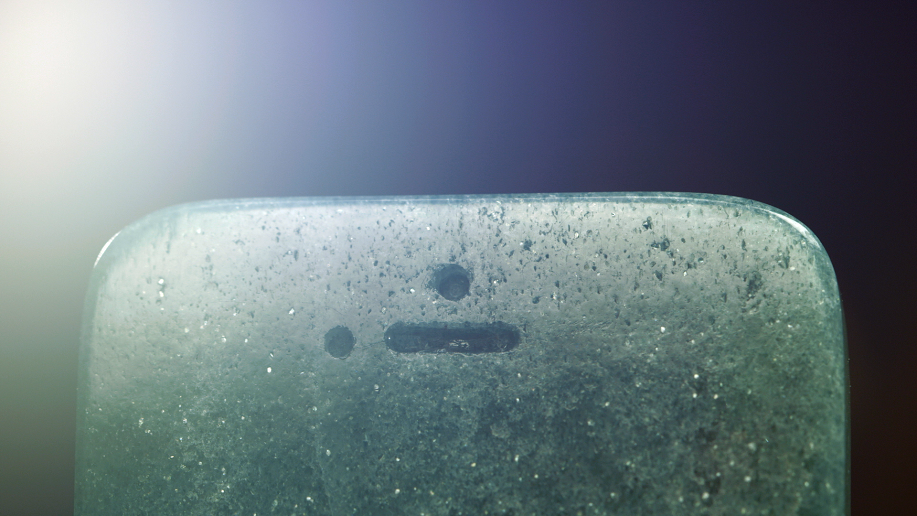
04 Oct Made of Stone: On Touching and Being Touched by Touchstone, by Stuart McLean
First of all a confession: I have never owned an iPhone. I have nonetheless experienced and felt myself susceptible to the allure of this most iconic of twenty first century artifacts – at once object of consumer desire, agent of seduction and, not least, communications device. Like many (most?) people I have often thought about acquiring an iPhone. What, then, has held me back? Perhaps I was deterred by the thought of yet another commodity jostling for my attention (and money) in an already overcrowded capitalist marketplace. Perhaps I feel ambivalent toward its instantly recognizable appearance and endlessly reproducible form. Or perhaps I feel uneasy at the prospect that the iPhone and other communications devices seem to hold out of being virtually connected to everyone and everything in the world while being increasingly poor in tangible, visceral, face to face connections with anyone or anything at all? Such, surely, is the predicament experienced by more and more people today. Amid the clamor of competing consumer goods and the frenetic demands of work and social life, can we find an alternative to the promise or threat of a universal but disembodied connectivity? What kind of device might answer to such a need? What might it look like? Feel like?
A change of perspective may be needed. The anthropologist Tim Ingold reminds us that the mulitifarious material culture that surrounds us and pervades our lives can be understood not just in terms of artifacts but also, equally importantly, in terms of materials and their transformations. The manufactured objects on which many of us depend are, he suggests, the effects of such transformations and represent not their cessation – the definitive imposition of humanly wrought form upon inert matter – but rather their temporary arrest or slowing down. What happens when an artifact like the iPhone is refashioned from materials other than the familiar and ubiquitous plastic? What can be said to have changed? Certainly its appearance, weight, density and tactile feel. The solidity and uniformity of its composition contrast, too, with the altogether more complex and differentiated interior of the ‘original.’ Its functionality has also changed: the new artifact is no longer a device for electronic communication (voice, text message, e-mail, internet etc.). It is, however, not simply a matter of loss – arguably something has been added too.
So what is it for, this new device, at once strange and familiar? Or perhaps that’s the wrong question. Perhaps – with a nod to Spinoza (himself a subversively materialist philosopher) – we should ask: what can this body of stone do? What kind of connections does this radically reconfigured communications device enable? The new materials – rose quartz, aventurine, sodalite – are themselves a form of communication. That is to say, they are not ‘new’ materials at all. They come trailing long histories of cultural associations, the accumulated traces of the various human communities who have encountered and made use of them over centuries or millennia, beginning long before the human invention of plastic as a preferred medium of mass manufacture. Rose quartz with its connotations of peace, healing, love and fulfilment. Aventurine, evoking the prospect of wealth and success in competitive situations. Sodalite, the bringer of calm and mental clarity. You can find inventories of various stones and their imputed qualities in the pages in medieval lapidaries, in the treatises of alchemists, or, today, on the shelves of New Age bookstores, as well as in the writings of anthropologists, folklorists and cultural historians. You don’t need to look to the written word, though, – these same associations have long been more broadly present in our culture, in popular aesthetics and everyday discourse. The stones themselves are nodes of interconnection, placing us in communication with a host of other times and places.
The voiceover in the commercial states: “With Touchstone, you hold in your hand the promise of connecting to something larger than all of us.” It is surely significant that this “something larger” is indeed a “something” – something impersonal, that is, something inhuman. The stones evoke not only a dense web of humanly bestowed cultural meanings but also a mineral reality long pre-existing the first appearance of humans, or indeed of any life on earth. In this sense they represent the geologic substrate not only of cultural intelligibility and meaning but of all animacy, all biological existence, human or otherwise. Certainly, Touchstone bears an unmistakably human imprint. Shaped to mimic the familar contours of the iPhone, it reminds its users that its geomentric lines and smooth surfaces are the result of self-conscious design and intentional labor. The stone body that we hold in our hand or slip into our pocket has been worked upon and transformed by human effort and in accordance with human aspirations and purposes. Yet its mineral origins remain conspicuous. Feel its weight in your pocket – so much more noticeable than that of the plastic artifact it references. Or take it out, clasp it in your palm, register its coldness to the touch, run your fingertips over its surface (different stones not only look different but feel different). Stones are not simply blank surfaces onto which successive human communities have projected their own meanings; rather the material properties of stones have influenced and infused the human imaginings that have sprung from them. Touching Touchstone you are reminded that the story of this present-day artifact, crafted to assuage the anxieties of early twenty first century life, reaches back into an aeons long geologic prehistory – that of the terrestrial globe itself as the precondition of all human making. The solidity and apparent fixity of the object you are handling are, in fact, the result of often violent geological processes – volcanic eruptions, magic surgings, forceful foldings and refoldings of the earth’s crust.
Earth scientists and more recently humanities scholars have taken to informing us with increasing frequency that we live in what has come to be called the “Anthropocene” era. The phrase is intended to call attention to the magnitude of humanity’s environmental impact by suggesting that humans – at least since the industrial revolution and the burning of fossil fuels on a massive scale – have come to represent a geological epoch in their own right. If Touchstone transforms a globally familiar contemporary device by replicating its form through the medium of stone rather than plastic, one often-cited indicator of the advent of the Anthropocene has been the ongoing insinuation of plastic as a material created by humans into the geological record: islands floating in the Pacific ocean formed by the accretion of discarded plastic; plastic granules intermingled with the sand on many of our beaches; plastic fused with rock on the coasts of Hawaii, forming a new material known as plastiglomerate.
Is Touchstone’s seeming reversal of this trajectory to be understood, then, as part of its healing, therapeutic message? Not necessarily. The concept of the Anthropocene seems at first glance to inflate the significance of the human presence on earth to an unprecedented degree: a whole geological period, all to ourselves! Yet it can be understood conversely as cutting us down to size in the most radical fashion, by situating our brief existence as a species in the context of a vastly more expansive planetary chronology, in which the career of humanity is no more than a fleeting and transitory episode. One of the Anthropocene’s most unsettling implications is that one day humans, too, will be simply one more superceded geological stratum among others, one that may or may not be legible as such to some notional post-human intelligence, surveying the after-traces of our now vanished presence. Could it be that Touchstone signals such a possibility, albeit obliquely? Perhaps, after all, we shouldn’t be too reassured.
Tim Ingold. Being Alive: Essays on Movement, Knowledge and Description. (New York: Routledge, 2011).
Benedict de Spinoza. Ethics. Edwin Curley trans. (London: Penguin Classics, 2005).
Stuart McLean is Associate Professor of Anthropology and Global Studies at the University of Minnesota. He has carried out fieldwork in Ireland and the Orkney Islands. Much of his work is situated at the interface between art, anthropology and literary writing, with particular reference to the implication of material sites and processes in human imagination and world-making. He is also an affiliate of the Center for Advanced Applications.



